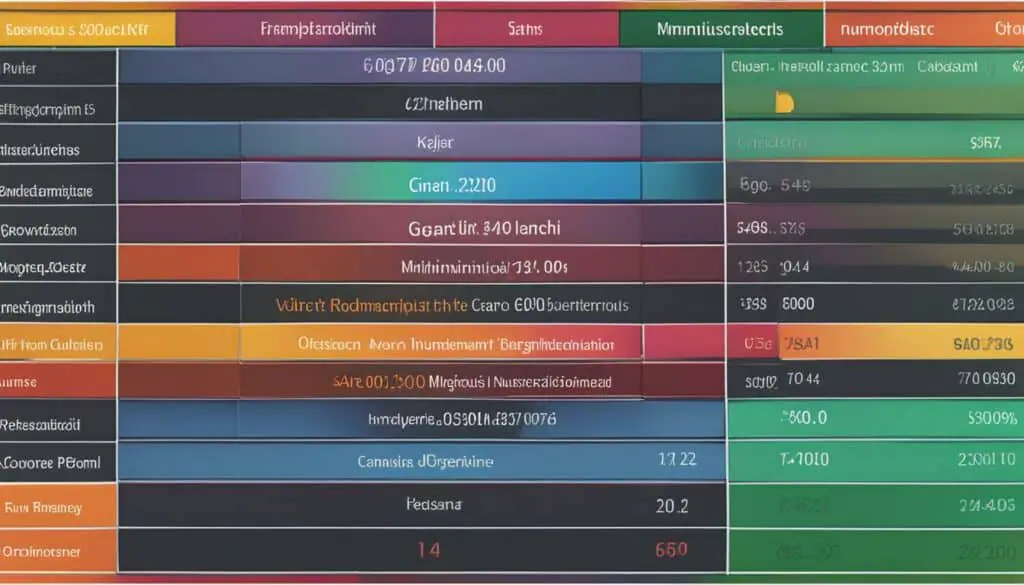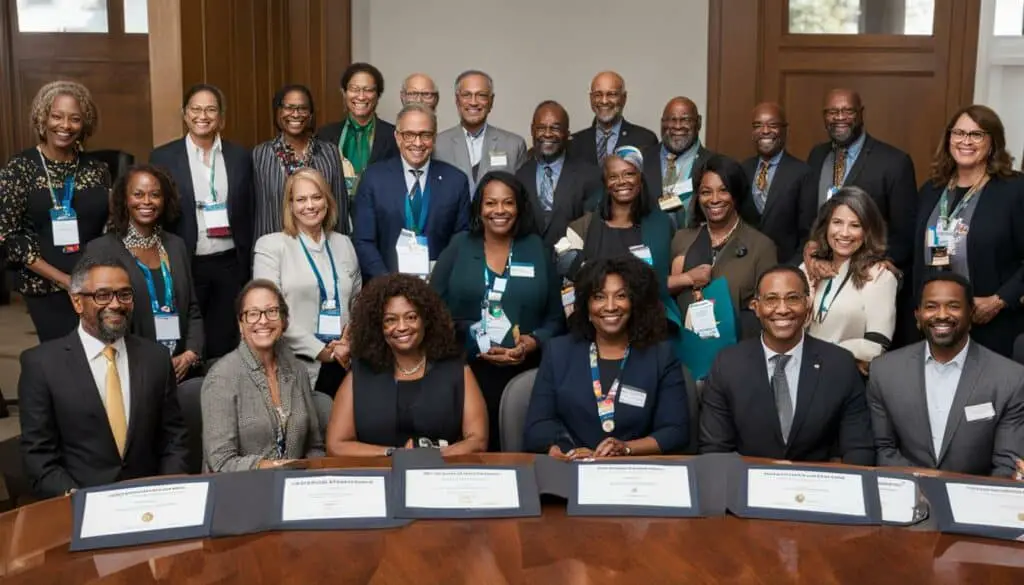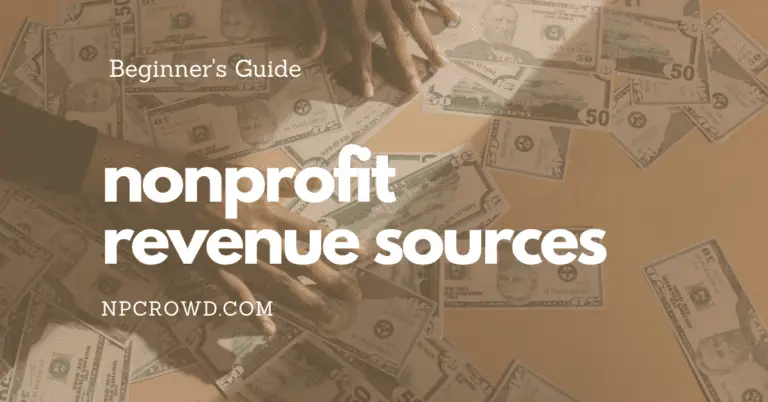4DX for Nonprofits: Strategy Execution Success
Disclaimer: This post may contain affiliate links. These links, if used and purchases made, we may earn a small commission. These affiliate programs do not impact the recommendations we make or the resources we refer you to. Our focus is on providing you the best resources for your nonprofit journey.
As champions of change and advocates for community advancement, we in the nonprofit sector understand the monumental power of strategic planning to drive organizational effectiveness. Yet, embarking on this journey is just the beginning—execution is where our visions come to life. Through our collective commitment, our mission, and the management of our resources, we turn possibility into action. Our ace in the hole? The 4DX model for nonprofits.Conceptualized by thought leaders Stephen R. Covey and Chris McChesney, the 4 Disciplines of Execution (4DX) provides a robust framework that transcends traditional nonprofit management. This methodology is not a mere momentary training event but an ongoing process demanding direct involvement from leaders who are in the thick of the action. In the world of nonprofit strategic planning, cultivating a culture built on focus, leverage, engagement, and accountability isn’t just advantageous—it’s imperative.
In weaving these threads into the fabric of our organizations, we’ve witnessed over 2000 entities worldwide augment their capacity to meet objectives with enviable excellence. The secret? A rigorous adoption of 4DX’s core principles that necessitate cultural and behavioral alterations, steadfastly focusing on those actions within our control—the essential lead measures—while keeping our eyes firmly on the prize: our strategic goals.
Key Takeaways
- The 4DX model is central to executing nonprofit strategic plans with precision and effectiveness.
- Embodied by focus, leverage, engagement, and accountability principles, 4DX transcends traditional nonprofit management practices.
- Success with 4DX for nonprofits hinges on commitment from teams and leaders close to the front lines, reinforcing organizational effectiveness.
- Overseeing the process—rather than merely dictating goals—is the hallmark of leadership in the 4DX paradigm.
- Culture and behavior within a nonprofit must align with 4DX principles to genuinely achieve and surpass strategic objectives.
- The emphasis on lead measures, rather than lag measures, is a counterintuitive but crucial aspect of the 4DX strategy execution.
Understanding the 4 Disciplines of Execution in Nonprofits
Within the nonprofit sector, the strategic planning process is a critical factor in determining our ability to make tangible differences in our communities. However, having plans on paper is just the starting point. It is the systematic, disciplined execution that transforms plans into outcomes, aligning efforts with missions, and intentions with achievements. Our quest for creating lasting impact brings us to embrace the 4 Disciplines of Execution, or 4DX, which provides a distinctive scaffold to elevate our strategic efforts into effective actions.
At its core, 4DX involves a set of principles designed to help organizations navigate through their daily operations and ensure the fulfillment of their most critical strategic priorities. It’s a blend of rigorous processes and flexible tactics which, when adopted, signify a departure from mundane methods to a path paved with focused intentionality. For us in the nonprofit realm, the model introduces a strategic rhythm—a cadence through which we can tackle the intrinsic challenges of our sector.
The Foundation of 4DX: Focus, Leverage, Engagement, and Accountability
Focusing on Wildly Important Goals (WIGs) in the midst of the inevitable whirlwind of activities, acting on Lead Measures to influence positive outcomes, keeping a compelling Scoreboard to visually track progress, and creating a Cadence of Accountability through regular check-ins define the essence of the 4DX model. It’s an operational paradigm shift, redirecting teams from solely measuring effects to proactively generating results.
For those of us committed to the growth and success of nonprofit organizations, these disciplines are not just tactics, but testaments to our dedication to nonprofit performance measurement and our belief in the transformative power of strategic planning for nonprofits. Through leadership development and an unwavering commitment to these principles, we can help our teams focus on what’s most pivotal to our cause, making execution a natural extension of planning.
The Unique Challenges of Applying 4DX within the Nonprofit Sector
Frequently, nonprofit organizations encounter complex landscapes marked by competing priorities and restricted resources. These challenges necessitate a paradigm of execution that is both agile and steadfast. Incorporating 4DX into our strategic thinking allows us to delineate goals clearly, invest in what truly moves the needle, and establish routines that counter the entropy of daily distractions. Nonprofit leadership development must, therefore, intertwine with the pillars of 4DX to foster an environment conducive to successful execution.
When aiming for significant milestones in nonprofit performance measurement or forging new pathways for strategic growth, the 4DX model stands as a beacon of structure and clarity. It empowers teams to discern and prioritize efforts, measure their stride towards meaningful objectives, and hold themselves responsible for the collective journey towards nonprofit efficacy and impact.
In conclusion, understanding and applying 4DX within our organizations is more than adopting a methodology—it’s about cultivating a culture of discipline where strategic goals are not just set but achieved through perseverance and collective effort. And in this journey, we, as champions of the nonprofit vista, can lead with innovation and unwavering resolve.
Setting Wildly Important Goals (WIGs) for Nonprofit Success
At the heart of every organization’s robust nonprofit growth strategies and nonprofit sustainability lies an essential practice: the ability to set and achieve Wildly Important Goals or WIGs. These goals are not just any regular targets; they are the core objectives that will propel our nonprofit to substantial growth and ensure its long-term endurance in a highly competitive and resource-limited environment. In the chaotic hustle of daily operations, known colloquially as the nonprofit whirlwind, it is imperative that we discern and prioritize these WIGs amidst an array of pressing tasks and responsibilities.

Identifying WIGs in the Midst of Nonprofit Whirlwinds
The whirlwind of day-to-day activities within our nonprofits can be overwhelming, often obscuring the vision toward our overarching objectives. However, the success of our mission depends on our ability to sift through these distractions and highlight our WIGs. These goals are the beacons that guide our energy and resources towards impactful outcomes. By recognizing the imperativeness of these goals, we equip ourselves with the clarity to navigate through the storm of routine tasks while keeping our long-term vision in sight.
Crafting Effective WIGs: From ‘X’ to ‘Y’ by ‘When’
The formula for crafting an effective WIG is straightforward yet powerful: moving from ‘X’ to ‘Y’ by ‘When’. This approach ensures that our goals are specific, measurable, and time-bound, enabling clear tracking and accountability. Setting WIGs this way allows us to target key areas of improvement crucial for enhancing our nonprofit sustainability and expansion. However, setting such goals is not without its challenges – it involves iterative refinement and a staunch commitment to narrowing our focus. Let’s explore these intricacies with an illustrative table:
| Current State (X) | Desired State (Y) | Completion Date (When) |
|---|---|---|
| $100,000 annual fundraising | $150,000 annual fundraising | December 31, 2023 |
| 200 weekly volunteer hours | 300 weekly volunteer hours | June 30, 2023 |
| Three active community programs | Five active community programs | September 15, 2023 |
Limiting our focus to one or two critical WIGs, despite the temptation to address every area of need, is a hallmark of effective strategic planning. It’s a conscious choice to channel our resources efficiently and drive significant advancement in those areas that matter most. By adopting this framework, we ensure that the pursuit of our WIGs is aligned with our aspirations for nonprofit growth and sustainability, allowing us to not just survive the nonprofit whirlwinds, but to thrive within them.
Choosing and Acting on Lead Measures
For us in the nonprofit sector, dedicated to nonprofit capacity building and enhancing organizational effectiveness, identifying and acting on Lead Measures is pivotal. These measures are the actionable steps that predict and impact the achievement of our Wildly Important Goals (WIGs). They are distinct from Lag Measures, which are retrospective and reflect the outcomes of past actions. Let’s delve deeper into how we can not only choose but also act on these critical factors to drive our missions forward.
Distinguishing between Lag and Lead Measures
Lag Measures often deceive us with the comfort of tangible outcomes, but they are lagging indicators of past performance, incapable of being influenced. In contrast, Lead Measures are the aspects within our control, the real-time activities we can adjust to ensure we’re on the path to fulfillment of our strategic objectives. Recognizing the difference between these two is crucial for effective strategy execution in any nonprofit organization.
Leveraging Lead Measures for Predictive Impact on Goals
In the spirit of driving our mission, we focus on Lead Measures that truly impact our goals. These forward-looking measures empower us to proactively steer our nonprofit towards success, rather than merely recording it in hindsight. Identifying these Lead Measures and harnessing our collective efforts to impact them directly becomes the cornerstone of turning our strategic plans into reality.
Consider the following table which illustrates examples of both Lag and Lead Measures in a common nonprofit scenario:
| Nonprofit Objective | Lag Measure (Reflective) | Lead Measure (Predictive) |
|---|---|---|
| Enhance community outreach | Number of individuals served | Outreach events conducted per month |
| Increase donor engagement | Total funds raised | Donor touchpoints per week |
| Boost volunteer recruitment | Volunteer hours logged | Volunteer training sessions held |
By measuring and adjusting these Lead Measures, we make direct inroads into advancing our WIGs and building the sustainability and effectiveness of our nonprofits. This proactive approach is how we, as a collective force of change-makers, can turn aspirations into tangible success.

Creating a Compelling Scoreboard for Your Team
In our pursuit of excellence in nonprofit performance measurement and strategic planning for nonprofits, we advocate vigorously for a tool central to the 4DX framework: a Compelling Scoreboard. Essential for keeping our team both informed and actively engaged, the scoreboard serves as a dynamic visual representation of our progress towards our Wildly Important Goals (WIGs).
Visibility and clarity are the hallmarks of an effective scoreboard. Just as a sports team can instantly see if they’re winning or not, our team’s scoreboard must clearly show, at a glance, our trajectory towards meeting objectives. With this powerful clarity, each team member can rapidly assess their contribution to our collective mission. Regularly updating this scoreboard maintains the focus and energy necessary to achieve the pinnacle of our mission-centric activities.
Imagine walking into our workspace and seeing a vibrant dashboard that encapsulates our diligence and progress. That’s the power of a well-designed scoreboard.
Let’s consider the elements that make a scoreboard not just informative, but truly compelling:
- It should reflect both Lead and Lag Measures, ensuring a balance between predictive and reflective indicators.
- The scoreboard needs to be accessible to all team members, fostering a shared sense of ownership and accountability.
- Updating the scoreboard should be a regular ritual, keeping the data fresh and the team’s actions aligned.
- Aesthetics matter—make it visually stimulating to evoke interest and sustain attention.
- It should inspire action by showing how individual contributions move the needle.
Here we present an example of a compelling scoreboard layout:
| Objective | Lead Measure | Target | Current Status | Deadline |
|---|---|---|---|---|
| Increase Community Engagement | Number of outreach events per month | 8 events | 5 events completed | End of Quarter |
| Grow Donor Base | Donor engagement interactions per week | 20 interactions | 15 interactions | End of Month |
| Enhance Volunteer Program | Volunteer training sessions per month | 3 sessions | 1 session completed | Mid-Year |
The scoreboard unifies our team under a shared vision, allowing us to witness the impact of our collaborative efforts in real-time. Maintaining such transparency instills a sense of progress and cultivates a climate of continuous improvement within our organization. As we navigate the nuanced nuances of strategic planning for nonprofits, the scoreboard not only measures but galvanizes our pathway to nonprofit success.

4DX for Nonprofits: Fostering Organizational Engagement
As we delve into the realm of nonprofit leadership development and nonprofit fundraising strategies, it is clear that the heart of success lies in deep engagement of all team members. Through the 4DX framework, we aim to imbue our every action with intention and focus. Introducing simple, visible scoreboards is a transformative step in cementing this engagement—offering a physical manifestation of our goals and progress.
The Role of Simple and Visible Scoreboards
Indeed, one cannot underestimate the power of simplicity in driving formidable results. A scorecard that is both easy to understand and readily accessible serves as a constant reminder of our group’s objectives. These scoreboards foster a culture where every team member feels integral to the success of our mission. By ensuring that our progress is tangible, we cherish every win and learn from every shortfall. Such clarity instills a heightened sense of participation and, ultimately, ownership over the outcomes of our collective labor.
Let’s envision a scoreboard design that’s both intuitive and encouraging:
| Key Objectives | Progress Indicators | Target Goals | Actual Performance |
|---|---|---|---|
| Expand Donor Base | Monthly Outreach Events | 4 Events | 2 Completed |
| Boost Volunteer Training | Volunteer Training Hours | 50 Hours | 35 Hours |
| Advance Leadership Skills | Workshops Attended | 3 Workshops | 1 Workshop |
How Engagement Drives Nonprofit Mission Fulfillment
Engagement is more than just a catchphrase in nonprofit circles; it’s the driving force that propels our initiatives forward. When individuals can quickly assess the impact of their contributions, motivation swells, invigorating them to push the boundaries of what’s possible. This kind of engaged atmosphere acts as a fertile ground for innovation and creative nonprofit fundraising strategies—essential ingredients for sustained success in the competitive nonprofit space.
In fostering such an environment, we acknowledge that each member’s engagement is not only beneficial but vital to achieving our Wildly Important Goals. It is our collective pulse that keeps the mission alive and thriving. And as we continue to nurture this habitat of involved stewardship, the fruits of our labor will reflect a nonprofit that is not only effective but also adaptive and resilient.
Drawing strength from our shared commitment, and guided by the touchstone of our 4DX principles, we are poised to exceed expectations—each one of us, a cornerstone in the edifice of our mission’s success.
Maintaining a Cadence of Accountability in Teams
In the pursuit of organizational effectiveness and nonprofit sustainability, it’s paramount that we establish a consistent Cadence of Accountability within our teams. Doing so ensures that the whirlwind of daily tasks does not overshadow our Wildly Important Goals (WIGs). This structured approach is not only critical for aligning with our strategic plan but also for fostering a culture where accountability becomes part of our routine—a testament to our commitment to excellence in nonprofit management.
Implementing Effective WIG Sessions
We recognize that effective WIG sessions are the heartbeat of maintaining accountability. These regular gatherings allow team members to collectively review progress, celebrate successes, and identify areas needing attention. We commit to these sessions, knowing that they are catalysts for continued progress and emblematic of our dedication to our cause.
Here’s a snapshot of what our WIG sessions encompass:
- Review of the WIGs with clarity and purpose
- Assessment of the past week’s performance against Lead Measures
- Resolution of challenges impeding progress
- Commitment to actions for the coming week
Building a Rhythm of Regular Accountability Checks
Our commitment to nonprofit management extends beyond WIG sessions. We weave a rhythm of accountability into the very fabric of our operations. Regular checks—simple yet profound—are scheduled to keep everyone on track, ensuring that our actions consistently align with our goals.
Here is a practical table for our rhythm of accountability:
| Frequency | Activity | Outcome |
|---|---|---|
| Weekly | WIG Session | Team alignment and commitment to actions |
| Bi-weekly | Progress Updates | Assessment of Lead and Lag Measures |
| Monthly | Strategic Review | Orientation towards long-term objectives |
| Quarterly | Impact Analysis | Evaluation and recalibration of strategies |
These checks are not mere routines; they are pillars that support our journey towards nonprofit sustainability and effectiveness. As we engage in this cadence, we are reassured that our goals will not be lost to the day-to-day flurry but will remain in clear sight—a guiding constellation for our collective endeavor.

Execution at All Levels: The Leader Certification Process
In the landscape of nonprofit capacity building, leaders play a crucial role in charting the course from strategic planning to tangible achievements. Our commitment to nonprofit growth strategies necessitates a robust Leader Certification Process, vital for the seamless execution of the 4 Disciplines of Execution (4DX) model. This certification process stands as a bastion of leadership expertise, fortifying the capacities of leaders to drive their teams toward unparalleled accomplishments.

Preparing Leaders for Successful 4DX Deployment
Fostering leaders who are adept in the 4DX framework is essential for sustaining organizational momentum and actualizing our Wildly Important Goals (WIGs). The Leader Certification Process is therefore tailored to equip leaders with the skills necessary for orchestrating WIG sessions, which play a pivotal role in maintaining focus on these goals. Beyond this, leaders must be proficient in designing engaging scoreboards that not only track but energize teams towards collective aims, ensuring that accountability is rooted in our shared ethos.
Rollout Strategies: From Senior Leaders to Frontline Teams
The trenchant value of 4DX comes alive when embraced by the entire spectrum of leadership, from high-level strategists to those engaged in the frontline dynamism of nonprofit work. The Leader Certification Process is therefore a conduit for ensuring that leaders at every tier are equipped to cascade these principles down the ranks. A tactical approach to the rollout involves meticulous planning and a customized curriculum that synchronizes with the specific context and challenges of each nonprofit. Success lies in a tailored deployment strategy that harmonizes the instincts of senior management with the inner workings of frontline teams, fostering a culture where the ethos of 4DX is interwoven into the very fabric of the organization’s operative modalities.
As we proceed, let us not forget that the implementation of a successful Leader Certification Process is intrinsic to the enduring impact of our nonprofit missions. It is a rigorous yet rewarding path that cultivates ‘leaders as teachers’, fostering an empowerment that ripples through the ranks to engender an ecosystem where strategic imperatives are transformed into a living, thriving organizational reality.
Nonprofit Leadership Development through 4DX Principles
The paradigm of nonprofit leadership development demands more than just theoretical knowledge; it requires a mastery in the art of execution. In the fluid and dynamic world of nonprofits, where change is a constant, the 4 Disciplines of Execution (4DX) emerges as a critical tool in crafting leaders equipped to transform vision into reality. As we engage with strategic planning for nonprofits, we place a high premium on the discipline and execution that 4DX embodies.
Instilling a Culture of Discipline and Execution
Embedding a culture of discipline and accountability is at the heart of 4DX. This framework is the bedrock upon which the principles of strategic planning for nonprofits stand. It’s about setting a high bar for performance and aligning every team member with the organization’s most crucial priorities. By adhering to the tenets of 4DX, future nonprofit leaders can sharpen their focus, leverage their best efforts, engage their teams, and, above all, hold themselves and their colleagues accountable for the committed actions.
The Role of 4DX in Fostering Future Nonprofit Leaders
As the bredth of nonprofit leadership development continues to expand, the 4DX model serves as a promising compass. It orients emerging leaders towards outcomes that command collective commitment and robust strategic planning for nonprofits. Beyond the confines of theoretical training, 4DX instills practical approaches, ensuring leaders are sculpted to rise above the whirlwind of everyday demands and drive mission-critical goals to fruition.
Now allow us to share a snapshot of how 4DX principles can be embedded in the journey of aspiring nonprofit leaders:
- Focus on Wildly Important Goals (WIGs): We coach future leaders to distill the essence of organizational vision into actionable, achievable goals.
- Act on Lead Measures: We empower them to identify and influence performance metrics that directly affect the achievement of those goals.
- Keep a Compelling Scoreboard: We teach them that visibility of progress is key, and encourage maintaining simple, yet informative, visual scoreboards.
- Create a Cadence of Accountability: We instill the habit of regular, purposeful team meetings that sustain momentum and foster ownership.
In recognition of these four disciplines, we are not only shaping effective leaders but also stewards of innovation and resilience within the nonprofit sector.

As we look to the future, embracing 4DX principles in nonprofit leadership development is not an option—it’s a strategic imperative. This dedication to empowerment, honed through practical application and reflective learning, is how we will grow leaders who can navigate complexities and lead with courage and clarity. Together, we stand committed to molding a new era of leaders who are ready to elevate the nonprofit sector to unprecedented heights.
From Planning to Action: Avoiding the Pitfalls in Execution
In our quest to enhance nonprofit sustainability and elevate our nonprofit management strategies, we recognize that the journey from strategic planning to meaningful action is fraught with potential obstacles. Addressing these challenges head-on is essential for the successful implementation of our nonprofit fundraising strategies and for advancing our mission as a whole.
Identifying and Overcoming Common Failure Points
Firstly, we need to pinpoint common failure points that could derail our execution efforts. One such failure point is a lack of resolute commitment from senior leaders within our nonprofit. The sheer determination and endorsement from our organization’s vanguard are crucial for driving nonprofit management strategies and realizing our ambitions. Another common pitfall is the presence of leaders who are not fully equipped or certified to execute the 4DX principles effectively. Meticulous leader certification is non-negotiable; it ensures that our leaders can steer our teams with expertise and insight.

Ensuring Commitment and Consistency Across the Organization
Securing an organization-wide commitment to the 4DX method is indispensable for our nonprofit’s success. This involves a consistent application of the 4DX principles across all levels, affirming our dedication to making an impact through tangible actions. Furthermore, building consistency in our approach to problem-solving and decision-making aids in galvanizing our teams towards achieving our Wildly Important Goals (WIGs).
To illustrate how we can strengthen our commitment and consistency, let us consider the following action table:
| Action Item | Description | Impact on Nonprofit Sustainability |
|---|---|---|
| Strengthen Leadership Commitment | Engaging senior leaders in regular review sessions focused on 4DX adherence and strategic progress. | Increases the likelihood of strategic initiatives moving from planning to successful execution. |
| 4DX Leader Certification | Providing comprehensive training and resources for leaders at all levels to master 4DX principles. | Ensures that execution strategies are effectively communicated and implemented throughout the nonprofit. |
| Routinize Strategy Reviews | Establishing fixed intervals for strategy performance assessments, realigning efforts as needed. | Creates a structure for continuous improvement and agile response to strategic challenges. |
By tackling these common stumbling blocks with a proactive and structured approach, we’re setting the stage for our initiatives to flourish. It’s a collaborative effort, wherein each of us plays a pivotal role in fostering an environment where excellent execution is not just an ideal but a reality.
Conclusion
As we draw the curtains on our exploration of the 4DX framework, we reflect on its transformative effects within the nonprofit sector. Embracing 4DX has empowered us to refine our strategic planning for nonprofits, propelling us beyond the foundational aspects of nonprofit capacity building directly towards a realm of sustained growth and actionable results. With disciplined execution central to 4DX, nonprofits like ours are paving the way for a future where achieving mission-driven objectives isn’t an aspiration but a tangible reality.
4DX as an Operating System for Nonprofit Growth
In our journey, we’ve seen firsthand how 4DX serves not just as a methodology, but as an operating system for nonprofit organizations. By adhering to its principles, we are able to build a foundation that supports a cycle of continuous improvement, innovative action, and strategic foresight. This robust framework anchors us firmly in our pursuit of broadening our impact, ensuring that every endeavor we undertake is executed with precision and aligned with our overarching goals.
Transforming Strategy into Action, Measurement, and Sustainability
At the nexus of nonprofit management and strategic objectives lies the critical need to transform our well-crafted strategies into measurable actions. This is where 4DX principles shine, moving us beyond planning phases to realization and assessment. It is through this unwavering lens of measurement and accountability that our movements towards sustainability and amplified impact truly gain momentum. As we look to the horizon, it is with the assurance that through 4DX, our nonprofits are well-equipped to navigate complexities, optimize efforts, and sustain success in all our mission-centric endeavors.
FAQ
What does 4DX stand for in the context of nonprofits?
In the nonprofit context, 4DX stands for “The 4 Disciplines of Execution,” a framework designed to help organizations achieve their most critical strategic objectives in the midst of the inevitable daily urgencies.
What are the four disciplines central to the 4DX model?
The four disciplines are 1) focusing on the Wildly Important Goals (WIGs), 2) acting on the Lead Measures, 3) keeping a compelling Scoreboard, and 4) creating a Cadence of Accountability.
How are Wildly Important Goals (WIGs) identified in a nonprofit setting?
WIGs are identified by determining which goals are most critical for the organization’s success and will make all the other goals easier to achieve or irrelevant. They are set to focus efforts amid the myriad of competing priorities in nonprofits.
What differentiates Lead Measures from Lag Measures?
Lead Measures are predictive and influence the accomplishment of your WIGs, focusing on activities that you can control. Lag Measures, in contrast, are the outcomes that result from past performance, reflecting the achievement of your goals.
How does a compelling scoreboard contribute to the success of 4DX?
A compelling scoreboard visually tracks progress towards the WIGs, keeps the team engaged, and helps maintain accountability by making it clear whether they are winning the game.
What role does organizational engagement play in executing 4DX strategies?
Organizational engagement is crucial in the execution of 4DX, as it ensures that team members are emotionally and psychologically invested in the organization’s WIGs, driving them to put in the effort needed to reach these goals.
Why is the Cadence of Accountability important in nonprofit teams?
A regular Cadence of Accountability ensures that team members keep WIGs top of mind, regularly review their commitments to lead measures, and sustain progress towards goals despite the whirlwind of other activities.
How does the Leader Certification Process contribute to the 4DX framework?
The Leader Certification Process equips leaders with the skills and knowledge needed to effectively facilitate WIG sessions, design scoreboards, and maintain team accountability, ensuring the proper implementation of the 4DX model at all organizational levels.
How does 4DX facilitate nonprofit leadership development?
4DX promotes consistent practices and disciplines necessary for achieving strategic objectives, which helps in developing nonprofit leaders who are capable of managing and leading teams effectively towards the organization’s mission.
How can nonprofits transition from strategic planning to effective action?
Nonprofits can make this transition by applying the 4DX model to identify WIGs, focus on lead measures, keep score, and maintain accountability; all while avoiding common pitfalls such as inconsistent leadership commitment or a lack of clarity in roles.
What common challenges do nonprofits face when implementing 4DX?
Nonprofits often deal with limited resources, many competing priorities, and a need for strong leadership buy-in. Implementing 4DX requires recognizing these challenges and ensuring that every level of the organization is aligned and committed to the execution process.
How does 4DX impact nonprofit fundraising strategies?
By using 4DX, nonprofits can better prioritize their fundraising efforts, track results, and hold their teams accountable to their fundraising goals, leading to more effective and strategic engagement with donors and stakeholders.
What makes 4DX an effective operating system for nonprofit growth?
4DX’s focus on disciplined execution of the most crucial goals allows nonprofits to rise above the daily operations hustle and strategically pursue growth, improving organizational effectiveness and sustainability.







